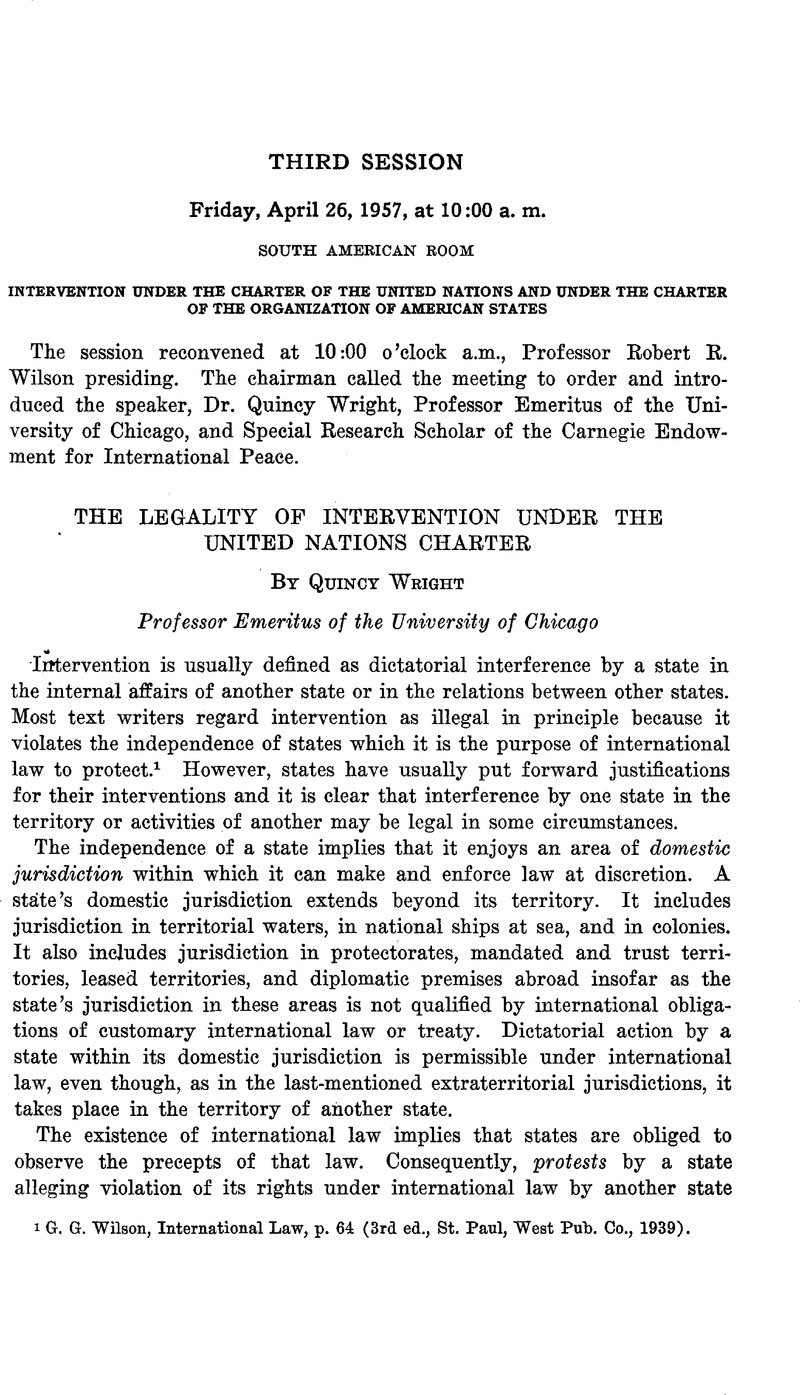Article contents
The Legality of Intervention Under the United Nations Charter
Published online by Cambridge University Press: 27 February 2017
Abstract

- Type
- Third Session
- Information
- Copyright
- Copyright © American Society of International Law 1957
References
1 G. G. Wilson, International Law, p. 64 (3rd ed., St. Paul, West Pub. Co., 1939).
2 Ellery Stowell (Intervention in International Law, Washington, Byrne, 1921) suggests that states cannot legally qualify their basic sovereign rights any more than an individual can, in modern states, contract away basic liberties, but the World Court has regarded the making of treaties as an exercise, not a limitation, of sovereignty (see note 13 below).
3 U.N. Charter, Arts. 41, 42. It is controversial whether the Security Council can take measures to enforce a judgment of the International Court of Justice under Art. 94, unless necessary to maintain international peace and security.
4 1 Oppenheim, International Law, see. 136, p. 254 (5th ed., Lauterpacht).
5 Ibid., sec. 129, p. 243. Stowell (op. cit.) seeks to justify such political and humanitarian interventions on legal grounds.
6 “Historicus,” Letters on Some Questions of International Law 41 (London, 1863).
7 Emerich Vattel, Le droit des Gens, III, Chap. 3, pars. 44, 49, pp. 248, 251 (Washington, Carnegie Endowment, Fenwiek trans.). Similar views were expressed by Gentili, Grotius, Pufendorf and Wolff. See Quincy Wright, Problems of Stability and Progress in International Belations 68 ff. (Berkeley, University of California Press, 1954).
8 Quincy Wright, “Intervention, 1956,” 51 A.J.I.L. 257 (1957).
9 Art. 1.
10 Art. 2, pars. 3, 4.
11 Art. 39.
12 Art. 2, par. 1.
13 See The Wimbledon, P.C.I.J., Ser. A, No. 1, p. 25; 1 Hudson, World Court Reports, 175.
14 Ibid., and Mosul Case, 13, No. 12, p. 25, Hudson, op. cit. 737; North Atlantic Fisheries Arbitration, 1 Scott, Hague Court Eeports 157.
15 Note, April 15, 1957, printed in New York Times, April 16, 1957.
16 Note 8 above.
17 Quincy Wright, “The Prevention of Aggression,” 50 A.J.I.L. 526 (1956); Cursos Monograficos, Academia Interamericana de Derecho Comparado e Internacional, Havana, 1956, Vol. 6, p. 401.
18 Art. 39.
19 Note 8 above.
20 Charles De Visscher, Theory and Eeality in Public International Law 328 (Corbett trans., Princeton University Press, 1957).
21 Quincy Wright, A Study of War 8, 698 (University of Chicago Press, 1942); The Study of International Relations 229 (New York, Appleton-Century-Crofts, 1955).
22 Note 8 above.
23 W. E. Hall, International Law, sees. 92, 95. See also Oppenheim, op. cit., Vol. 1, sec. 137.
24 Charles Cheney Hyde and Louis B. Wehle, “The Boycott in Foreign Affairs,” 27 A.J.I.L. 1 (1933).
25 Art. 2, par. 6. The Charter was intended to establish a universal organization which could control non-members for the maintenance of international peace and security.
26 Art. 11 authorizes such recommendations by the General Assembly, and Art. 39, by the Security Council.
27 The “inherent right” of self-defense under customary law permits action in case of an immediate danger of attack, or, as Secretary of State Webster said in the Caroline Case, “a necessity for defence, instant, overwhelming, and leaving no choice of means, and no moment for deliberation.” (2 Moore’s Digest of International Law 412.) The general prohibition against the use of force in the Charter seems to require that Art. 51 be interpreted to cut down this “inherent right” to response to an actual “armed attack.” In the discussion of the Baruch proposal for atomic energy control, however, it was generally agreed that seizure of an atomic energy installation in violation of a control treaty, even in a state's own territory, should be considered equivalent to an armed attack.
28 When Members in response to a United Nations recommendation intervene against a non-member, as in the Korean Case, the action can be considered “collective security” only on the assumption that the United Nations has a universal competence in the field of international peace and security as suggested by Art. 2, par. 6.
29 Note 27 above.
30 J . L. Brierly, The Law of Nations 295 ft. (4th ed., Oxford University Press, 1949); Quincy Wright, Problems of Stability and Progress, op. cit. 27.
31 Q. Wright, “Domestic Jurisdiction and the Competence of United Nations Organs,” Ninth Eeport, Charter Review Conference, Commission to Study the Organization of Peace, pp. 50 ff. (New York, 1955); Cursos Monografieos, Academia Interamericana de Derecho Comparado e Internacional, Havana, 1956, Vol. 6, pp. 350 ff.
- 1
- Cited by




